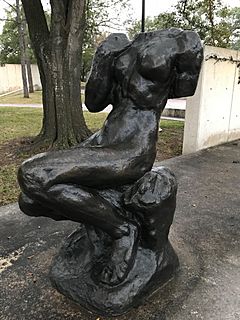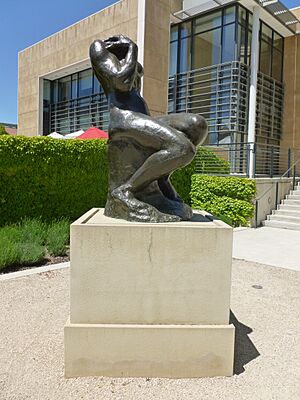Cybele (sculpture) facts for kids
Quick facts for kids Cybele |
|
|---|---|

A bronze cast in Houston's Lillie and Hugh Roy Cullen Sculpture Garden in 2019
|
|
| Artist | Auguste Rodin |
| Year | c. 1889-90/Enlarged 1904 |
| Type | Sculpture |
| Dimensions | 160 cm × 79 cm × 120 cm (63 in × 31 in × 46 in) |
Cybele is a famous sculpture created by the French artist Auguste Rodin. It's special because it was one of the first times Rodin showed a "fragment" (a sculpture that isn't a full body) as a complete artwork, not just a study.
Contents
The Story Behind Cybele
Rodin was inspired by old Greek art. He also looked at unfinished works by Michelangelo. This led him to create a small model of a woman sitting down, but without a head.
In 1877, Rodin faced a problem. People wrongly thought he had made his sculpture The Age of Bronze by casting it directly from a real person. After this, Rodin usually chose to make sculptures that were smaller than life-size.
How the Sculpture Was First Shown
This large sculpture was first shown in Paris in 1905. It was part of an art show called the Salon de la Société Nationale des Beaux-Arts. At that time, it was simply called A Figure.
Rodin's friends and workers had a nickname for it. They called it Abruzzesi Seated. This name came from the woman who modeled for the sculpture.
Getting the Name Cybele
The sculpture didn't get its current name, Cybele, until 1914. Cybele is an ancient Phrygian mother goddess known for fertility.
A larger bronze version of the sculpture was shown in London that year. It was displayed as Cybele at an exhibition at Grosvenor House. The sculpture's full, strong shape might have made Rodin think of the goddess.
Where to See Copies

The original plaster version from the 1905 Salon is now at the Musée des Beaux-Arts de Bordeaux in France. Many bronze copies of Cybele have been made. You can find them in different places around the world, including:
- Victoria and Albert Museum, London (This copy was made in 1914. It's the only one made while Rodin was still alive.)
- Musée Rodin, Paris (This copy was made in 1981.)
- Brooklyn Museum, Brooklyn, New York (This copy was also made in 1981.)
- Iris & B. Gerald Cantor Center for Visual Arts, Stanford University, California (Another 1981 copy.)
- Lillie and Hugh Roy Cullen Sculpture Garden, Houston, Texas (This copy was made in 1982.)
- North Carolina Museum of Art, Raleigh, North Carolina (This copy was made in 1987.)

